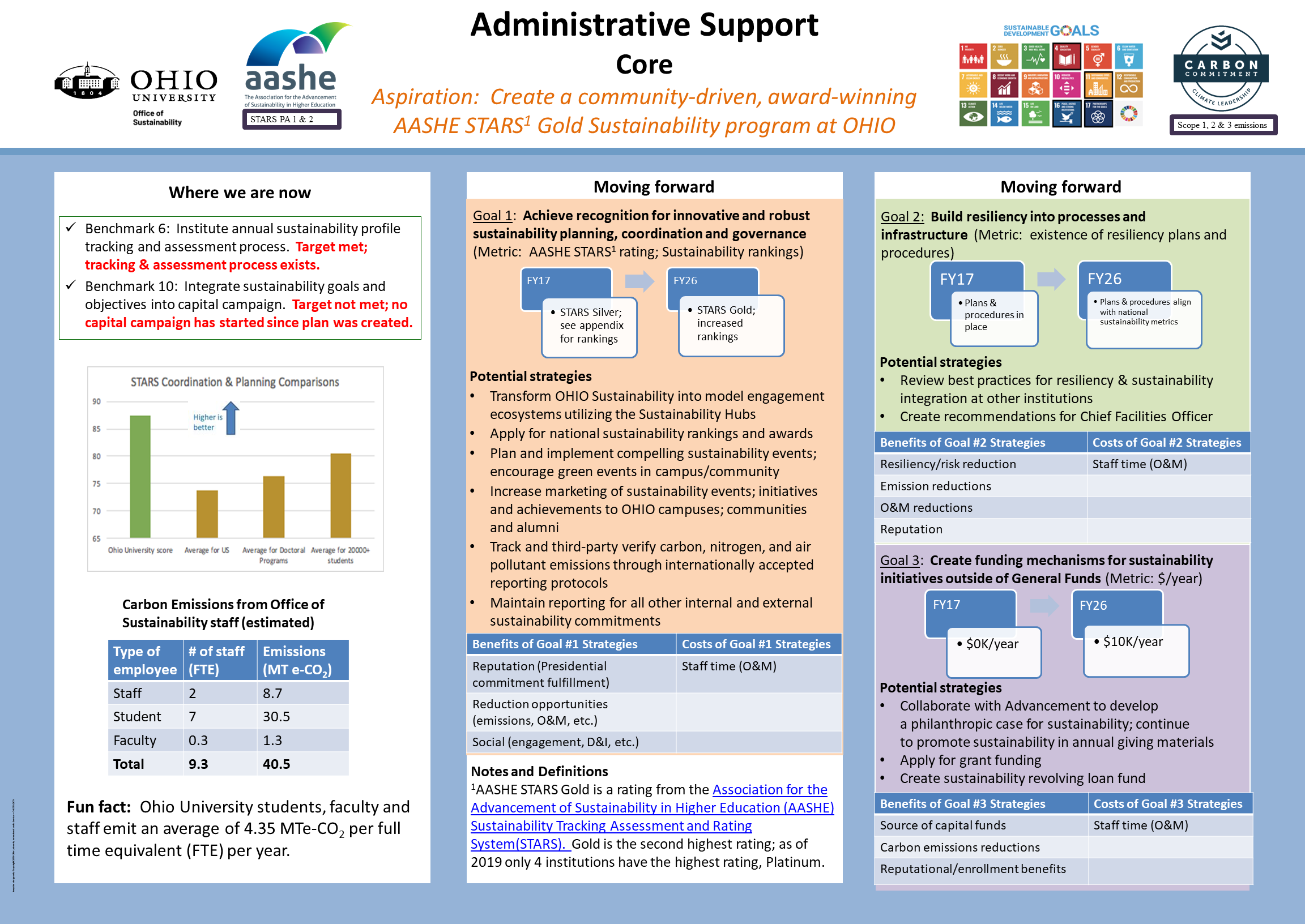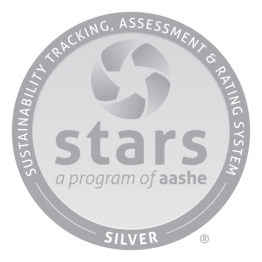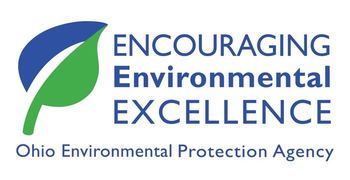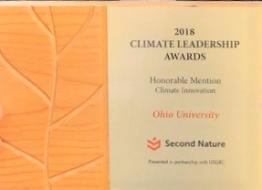About Sustainability
About the Office
Ohio University defines sustainability as the capacity to simultaneously benefit people, the planet and prosperity over a life-cycle. Life-cycle analysis, life-cycle costing, social financial proxies, and multi-criteria decision analyses are tools that are used to evaluate sustainability. Also used at Ohio University is a popular but less actionable definition, adapted from the Bruntland definition of sustainable development: sustainability is the ability to meet the needs of the present without compromising the ability of future generations to meet their needs.
As a signatory to the Carbon Commitment [formerly the American College and University Presidents' Climate Commitment (ACUPCC)], and the We Are Still In declaration, Ohio University provides timely and accurate reporting to Second Nature, the Association for the Advancement of Sustainability in Higher Education (AASHE), the US Green Building Association, and the US EPA Green Power Partnership through the Office of Sustainability. Ohio University is an AASHE Sustainability Tracking, Assessment and Rating System (STARS) Silver Institution.
The Office of Sustainability has 1 full time employee, 3 graduate student assistants, approximately 4 undergraduate student employees, 3 Sustainability Hubs, and 3 affiliated faculty Sustainability Hub Coordinators who all assist in achieving our mission (see below).
Please read below and browse our website to learn more about the Ohio University Office of Sustainability.
Mission and Goals
Ohio University's Office of Sustainability facilitates the implementation of the Ohio University Sustainability and Climate Action Plan by providing services and support to the campus community and ensures fulfillment of institutional commitments to environmental, social and economic well-being.
Specific goals for our office are found in the Sustainability and Climate Action Plan, Administrative Support theme (see below, and click here for more information).
History
In 2005, Ohio University welcomed a new office to campus: The Office of Resource Conservation. Under the direction of the Resource Coordinator, Sonia Marcus, this office thrived as it worked to promote sustainability and energy conservation efforts across its campuses. It was in that year that the OHIO Ecohouse, the University's premier sustainability living residence, was created. Many other important educational projects also occurred during this time.
When former President Roderick McDavis signed the American College and University Presidents' Climate Commitment (ACUPCC) in 2007, he assumed a strong leadership role by announcing the institution's intention to become a carbon neutral campus by the year 2075. Such a commitment allowed the Office of Resource Conservation to transition to the Office of Sustainability and begin the planning process involved in obtaining such this goal. Ohio University then became the first public institution in Ohio to hire a full-time Sustainability Coordinator (Sonia Marcus), who remained in that position through 2010.
In 2011, the University's first formal Sustainability Plan was adopted under the direction of Interim Sustainability Coordinator Erin Sykes. Implementation of that plan began at the same time that the Office of Sustainability welcomed a new Director of Sustainability, Annie Laurie Cadmus. In 2012, the first Climate Action Plan was adopted by Ohio University. In 2015, the Office of Sustainability expanded by welcoming two new Full-Time Equivalent positions to the team: the Sustainability Specialist (Elaine Goetz) and the Sustainability Project Coordinator (Sam Crowl).
In January 2018, Annie Laurie Cadmus took a different position at the University, and Elaine Goetz became first the Interim Director, and then the permanent Director in November, 2018. Sam Crowl became the Associate Director. At that time, Sustainability at Ohio University was restructured to align with Former President Duane Nellis's Strategic Pathways and Priorities by creating engagement ecosystems called Sustainability Hubs, led by three affiliated faculty members, and a University-wide Sustainability Committee was formed.
In June, 2021, the Ohio University Board of Trustees approved the 2021-2026 Sustainability & Climate Action Plan, and a new carbon neutrality date of 2050.
In April 2023, Sam Crowl became the Director of Sustainability.
This office is constantly evolving to adapt to a changing environment, culture and economy. Students, faculty, staff, and community members who have recommendations for the future roles played by the Office of Sustainability are invited to become involved by visiting our office or sending an email to sustainability@ohio.edu.
Commitments
Ohio University became a charter signatory of the American College and University Presidents Carbon Commitment (ACUPCC) when former President Roderick McDavis signed the commitment on March 15, 2007. As of 2015, the ACUPCC is housed under Second Nature and was renamed the Carbon Commitment..
On his first day in office, June 12, 2017, former President Duane Nellis signed the "We Are Still In" declaration, reaffirming Ohio University's commitment to carbon neutrality, the Paris Climate Accord, and the Carbon Commitment.
.
As a signatory of the Carbon Commitment, Ohio University is also a Race to Zero Universities and Colleges signatory. "Powered by the UN Environment Programme, EAUC & Second Nature - Race to Zero is a global campaign to rally leadership and action in the education sector."
Recognitions
Ohio University is an EPA Green Power Partnership Top 30 College and University as a result of purchasing green power in amounts that meet EPA's requirements
Ohio University purchases 100% of electricity (~110,000 MWh/year) from Green-e renewable energy certificates (RECs, likely from Texas-based wind projects), as of Jan 1, 2021.
Ohio University has been recognized by the Arbor Day Foundation as a Tree Campus USA/Tree Campus Higher Education since 2017.
Ohio University is an AASHE (Association for the Advancement of Sustainability in Higher Education) STARS (Sustainability Tracking Assessment and Rating System) Silver institution.
Ohio University has over 1 million square feet of LEED certified building space.
Ohio University is a Silver level Bicycle Friendly University (BFU). The BFU designation is granted by the League of American Bicyclists. In 2022, Ohio University improved from its previous Bronze level BFU to Silver level.
Ohio University is a Bee Campus USA as of 2021. Bee Campus is an initiative of the Xerces Society.
Awards
In May 2018, Ohio University was awarded the Ohio EPA's highest environmental stewardship honor, the Encouraging Environmental Excellence (E3) Platninum-level recognition. Ohio University was the first university in Ohio to be awarded with this honor. Ohio University had previously achieved achievement and gold-level recognition.
In 2018, Ohio University was awarded Honorable Mention in the Climate Innovation division of the Second Nature Climate Leadership Awards. This national award was given to Ohio University because of various innovative initatives and collaborations.
In 2016, Ohio University received the national APPA Sustainability Innovation award "to recognize and promote unique and innovative sustainable practices in the educational facilities and campus environments."












